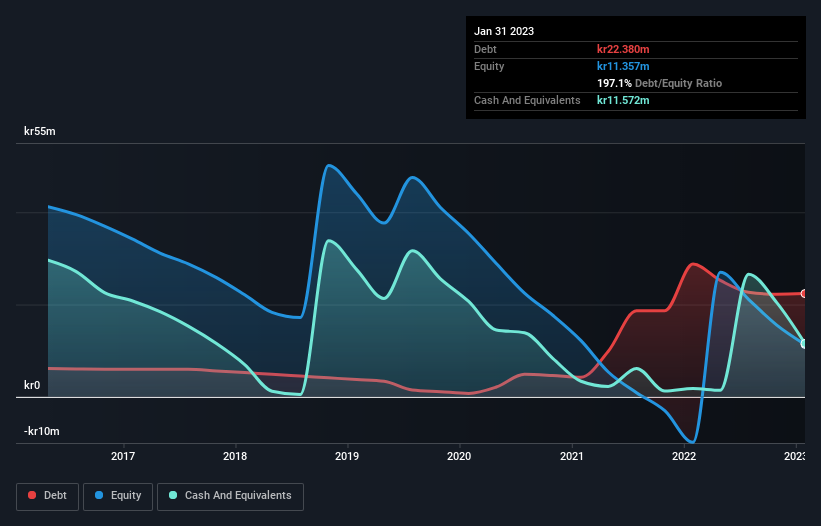- Sweden
- /
- Medical Equipment
- /
- NGM:PHI
Here's Why Phase Holographic Imaging PHI (NGM:PHI) Can Afford Some Debt
Warren Buffett famously said, 'Volatility is far from synonymous with risk.' It's only natural to consider a company's balance sheet when you examine how risky it is, since debt is often involved when a business collapses. We can see that Phase Holographic Imaging PHI AB (publ) (NGM:PHI) does use debt in its business. But the more important question is: how much risk is that debt creating?
When Is Debt A Problem?
Debt is a tool to help businesses grow, but if a business is incapable of paying off its lenders, then it exists at their mercy. In the worst case scenario, a company can go bankrupt if it cannot pay its creditors. However, a more usual (but still expensive) situation is where a company must dilute shareholders at a cheap share price simply to get debt under control. Of course, debt can be an important tool in businesses, particularly capital heavy businesses. The first thing to do when considering how much debt a business uses is to look at its cash and debt together.
Check out our latest analysis for Phase Holographic Imaging PHI
What Is Phase Holographic Imaging PHI's Debt?
You can click the graphic below for the historical numbers, but it shows that Phase Holographic Imaging PHI had kr22.4m of debt in January 2023, down from kr28.8m, one year before. However, because it has a cash reserve of kr11.6m, its net debt is less, at about kr10.8m.

How Strong Is Phase Holographic Imaging PHI's Balance Sheet?
Zooming in on the latest balance sheet data, we can see that Phase Holographic Imaging PHI had liabilities of kr6.02m due within 12 months and liabilities of kr22.4m due beyond that. Offsetting this, it had kr11.6m in cash and kr6.05m in receivables that were due within 12 months. So its liabilities outweigh the sum of its cash and (near-term) receivables by kr10.8m.
Of course, Phase Holographic Imaging PHI has a market capitalization of kr104.3m, so these liabilities are probably manageable. Having said that, it's clear that we should continue to monitor its balance sheet, lest it change for the worse. When analysing debt levels, the balance sheet is the obvious place to start. But you can't view debt in total isolation; since Phase Holographic Imaging PHI will need earnings to service that debt. So when considering debt, it's definitely worth looking at the earnings trend. Click here for an interactive snapshot.
Over 12 months, Phase Holographic Imaging PHI reported revenue of kr9.3m, which is a gain of 4.9%, although it did not report any earnings before interest and tax. We usually like to see faster growth from unprofitable companies, but each to their own.
Caveat Emptor
Over the last twelve months Phase Holographic Imaging PHI produced an earnings before interest and tax (EBIT) loss. Its EBIT loss was a whopping kr20m. Considering that alongside the liabilities mentioned above does not give us much confidence that company should be using so much debt. So we think its balance sheet is a little strained, though not beyond repair. We would feel better if it turned its trailing twelve month loss of kr26m into a profit. So in short it's a really risky stock. There's no doubt that we learn most about debt from the balance sheet. However, not all investment risk resides within the balance sheet - far from it. For instance, we've identified 5 warning signs for Phase Holographic Imaging PHI (4 can't be ignored) you should be aware of.
If, after all that, you're more interested in a fast growing company with a rock-solid balance sheet, then check out our list of net cash growth stocks without delay.
New: Manage All Your Stock Portfolios in One Place
We've created the ultimate portfolio companion for stock investors, and it's free.
• Connect an unlimited number of Portfolios and see your total in one currency
• Be alerted to new Warning Signs or Risks via email or mobile
• Track the Fair Value of your stocks
Have feedback on this article? Concerned about the content? Get in touch with us directly. Alternatively, email editorial-team (at) simplywallst.com.
This article by Simply Wall St is general in nature. We provide commentary based on historical data and analyst forecasts only using an unbiased methodology and our articles are not intended to be financial advice. It does not constitute a recommendation to buy or sell any stock, and does not take account of your objectives, or your financial situation. We aim to bring you long-term focused analysis driven by fundamental data. Note that our analysis may not factor in the latest price-sensitive company announcements or qualitative material. Simply Wall St has no position in any stocks mentioned.
About NGM:PHI
Phase Holographic Imaging PHI
A medical technology company, develops and markets non-invasive time-lapse imaging instruments in Sweden and internationally.
Worrying balance sheet with weak fundamentals.
Market Insights
Community Narratives


Recently Updated Narratives


MINISO's fair value is projected at 26.69 with an anticipated PE ratio shift of 20x


The Quiet Giant That Became AI’s Power Grid


Nova Ljubljanska Banka d.d will expect a 11.2% revenue boost driving future growth
Popular Narratives


The company that turned a verb into a global necessity and basically runs the modern internet, digital ads, smartphones, maps, and AI.


MicroVision will explode future revenue by 380.37% with a vision towards success



